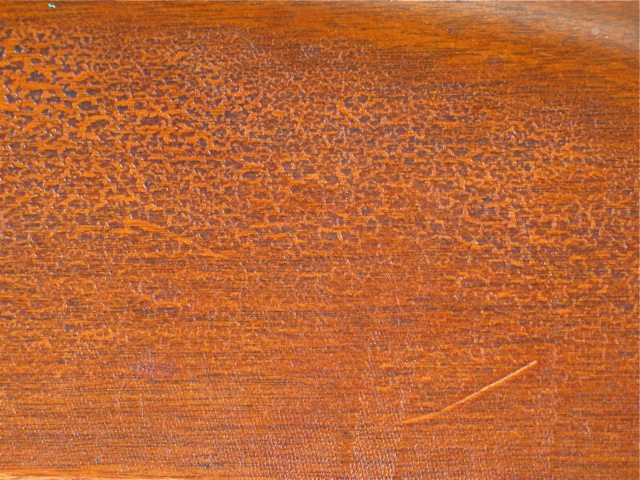We may receive a commission when you use our affiliate links. However, this does not impact our recommendations.

Close up of crazing from body sweat on a chair’s crest rail.
All finishes craze – that is, develop small cracks – as they age, especially if they are exposed to a lot of sunlight. But there’s another type of crazing, and it can happen much faster. This is crazing caused by body sweat.
You commonly see crazing of this type around cabinet-door pulls and drawer handles, and on chair backs, arms and wooden seats.
This type of crazing is caused by the acids in body sweat slowly breaking down the finish. The finish also softens and becomes dirty as dirt sticks to it. In severe cases the finish separates into small “islands.”
The finishes most prone to this type crazing are lacquer, shellac and water-based finish. Cross-linked finishes such as oil-based varnish and polyurethane, and two-part catalyzed finishes, are much more resistant.
If the crazing is superficial, you may be able to remove it by abrading with steel wool or an abrasive pad and still leave enough finish in good condition underneath to be functional. But usually, when the crazing has become bad enough to get you to do something about it, it’s too late for this. The finish has to be stripped and replaced, which usually means stripping and refinishing the entire door, drawer or chair.
— Bob Flexner
Here are some supplies and tools we find essential in our everyday work around the shop. We may receive a commission from sales referred by our links; however, we have carefully selected these products for their usefulness and quality.











So, if we expect heavy handling, we should either “pull a Schwarz” with something like a soap finish that will develop character with handling and use or go to a crosslinking finish and expect to strip and refinish every XX years.
There is a real argument for “starting with the finish” and going backwards through a build.
Thank you.
So preventing this sort of thing is all fine and dandy, but I suppose a more interesting question for a preservation expert might be how do you replicate this?
Crazing on cabinets:
Sweat and oil are bad enough. Now I am finding family members cook partially under cabinets and steam the finish with coffee makers, electric rice makers and the like. What non paint finishes are able to stand up best to this near daily episode steaming?. Should we give up and go to “paint.”?? Until I read the above discussion on crazing, I was thinking some form of polyurethane or simply go to an oil rubbed finish that can be easily “refreshed”
Cal
What finish options are there that are both resistant to humanity and reversible or repairable?
Oil-based varnish?
Or, if reversibility is tricky, what would be most easily repaired from the terrors of humanity?
And how well does wax protect over a finish from people of regularly refreshed?